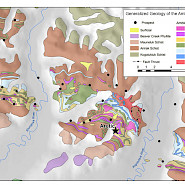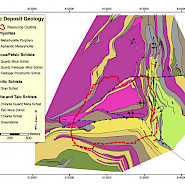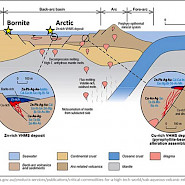The Arctic deposit is a polymetallic volcanogenic massive sulphide (“VMS”) style deposit hosted in the Ambler Belt, a group of Middle Devonian to Early Mississippian, metamorphosed, bimodal volcanic and volcaniclastic rocks with interbedded metasediments. VMS-style mineralization occurs along the 110-kilometer strike length of the belt.
Mineralization at Arctic forms semi-massive to massive sulphide beds composed of coarse-grained sulphides consisting mainly of chalcopyrite, sphalerite, galena, tetrahedrite, arsenopyrite, pyrite and pyrrhotite within graphitic and quartz mica (+/- chlorite) schists. The sulphide beds average 4 meters in thickness but vary from less than 1 meter up to as much as 25 meters in thickness. The bulk of the mineralization is within an area of roughly 1 km2 with mineralization extending 250 meters below the surface.




